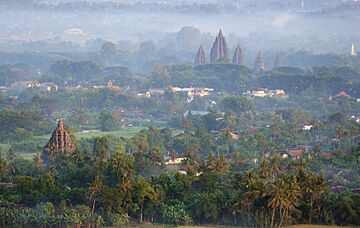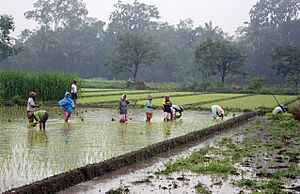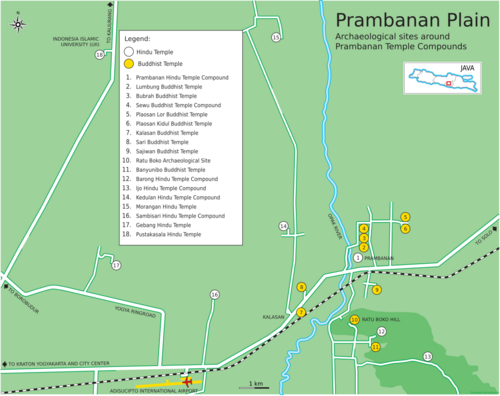Kewu Plain facts for kids

The Kewu Plain, also known as the Prambanan Plain, is a rich, flat area in Indonesia. It's located in Central Java, near cities like Yogyakarta and Solo. This plain is surrounded by mountains like Merapi and rivers like the Opak River.
For over a thousand years, this area has been very important in Javanese history and culture. Long ago, it was the heart of the powerful Mataram Kingdom from the 8th to 10th centuries. Later, in the 16th century, it became the center of the Mataram Sultanate. The plain is filled with many ancient temples and historical sites. In fact, thousands of temples from the 9th century were built across Central Java, including many here in the Kewu Plain.
Contents
Why Kewu Plain is Special
The Kewu Plain is home to many of Indonesia's oldest Hindu and Buddhist temples. The famous Prambanan temple complex is here. Nearby, you can find other important temples like Bubrah, Lumbung, and Sewu to the north. To the east is Plaosan temple, and to the west are Kalasan and Sari temples. Further west is Sambisari temple.
High up on a hill to the south is the Ratu Boko complex. All these sites are close to each other. This shows that the area was once a very important religious, political, and city center in ancient Java. The temples here are very diverse and complex. Some people even compare them to the amazing ancient sites at Angkor in Cambodia. Borobudur and Prambanan are especially famous and are often seen as Indonesia's answer to Angkor Wat.
Protecting Ancient Sites
In 2012, experts suggested that the area around Prambanan should become a special "sanctuary." This means protecting about 30 square kilometers of the plain. The goal is to keep major temples like Prambanan, Ratu Boko, Kalasan, Sari, and Plaosan safe.
This sanctuary would be like the Angkor archaeological area in Cambodia. It would stop new tall buildings or cell phone towers from being built. This helps protect the beautiful old sites from being blocked by modern structures. It also prevents too many hotels or restaurants from crowding the area.
Farming on the Plain
For hundreds of years, the Prambanan Plain has been known for its rich, fertile soil. This soil comes from the nearby Merapi volcano. It's perfect for growing lots of rice.
The economy of ancient Java depended heavily on rice farming. The old kingdoms of Central Java grew strong and rich because of the rice grown on this plain. You can even see pictures of rice farming on the stone carvings (bas-reliefs) at Borobudur and Prambanan temples.
The early Mataram Kingdom collected taxes from rice harvests. Java was famous for having extra rice to sell to other places. Rice farming also helped the island's population grow. Many of the rice fields you see today look much like they did centuries ago.
Amazing Archaeological Sites
The Kewu Plain is home to many incredible ancient sites. Here are some of the most important ones:
- Kalasan. This is thought to be the oldest temple on the plain, built in the early 8th century. It's a Buddhist temple built to honor a female spiritual figure named Tara.
- Sari. This 8th-century temple was likely a home or place of worship for Buddhist priests. It has nine small towers (stupas) on top and two rooms below, possibly for meditation.
- Ratu Boko. This complex sits on top of a hill south of Prambanan. It has strong gates, bathing pools, and stone walls.
- Lumbung. This Buddhist temple has one main temple surrounded by 16 smaller ones.
- Bubrah. This Buddhist temple is connected to the nearby Sewu temple.
- Sewu. This large Buddhist temple complex is even older than Prambanan. Its original name was Manjusrigrha, and it was a royal Buddhist temple. It has a main temple surrounded by many smaller ones. You can see well-preserved guardian statues here.
- Prambanan. This is a huge Hindu temple complex from the 9th century, dedicated to the three main Hindu gods (Trimurti). Building such a grand Hindu temple likely showed that Hindu kings were powerful again in the Mataram Kingdom.
- Plaosan. This Buddhist temple was probably built in the 9th century. It's thought that a Hindu king built it for his Buddhist queen. It has two main temples with carvings of Bodhisattvas and Tara. There are also rows of slender stupas.
- Sojiwan. This Buddhist temple has carvings that tell stories about education. Its base and stairs are decorated with animal fables. Sojiwan might have been a special temple for a Buddhist queen.
- Banyunibo. A Buddhist temple with a unique roof design.
- Barong. A Hindu temple complex with a large, stepped stone courtyard. It's on a hill not far from Banyunibo and Ratu Boko.
- Ijo. A group of Hindu temples located near the top of Ijo hill. The main temple holds a large lingam and yoni, which are symbols of creation.
- Arca Bugisan. This site has seven Buddha and bodhisattva statues, some of which have fallen. They show different poses and expressions.
- Gebang. A small Hindu temple found in 1937 near Yogyakarta's northern ring road. It has a statue of Ganesha and interesting carvings of faces on its roof.
- Gana. This temple is rich in statues, carvings, and sculpted stones. It often shows children or dwarfs with raised hands. It's located in the middle of a housing area and has been under restoration since 1997.
- Sambisari. Discovered in 1966, this Hindu temple was buried 4 meters deep by volcanic mud (lahar). It has a main temple with a large lingam and yoni, and three smaller temples in front.
- Kedulan. Found in 1994 by sand diggers, also 4 meters deep. The square base of the main temple is visible, but the smaller temples are not fully dug out yet. This temple looks similar to Sambisari.
- Morangan. A Hindu temple complex buried several meters under volcanic ash. It's located northwest of Prambanan.
- Pustakasala. Discovered in 2009 on the grounds of the Indonesia Islamic University. Along with Morangan, these are the northernmost temples found in this area.
Gallery of temples in Kewu plain
See also
- Candi of Indonesia
- Kedu Plain




















